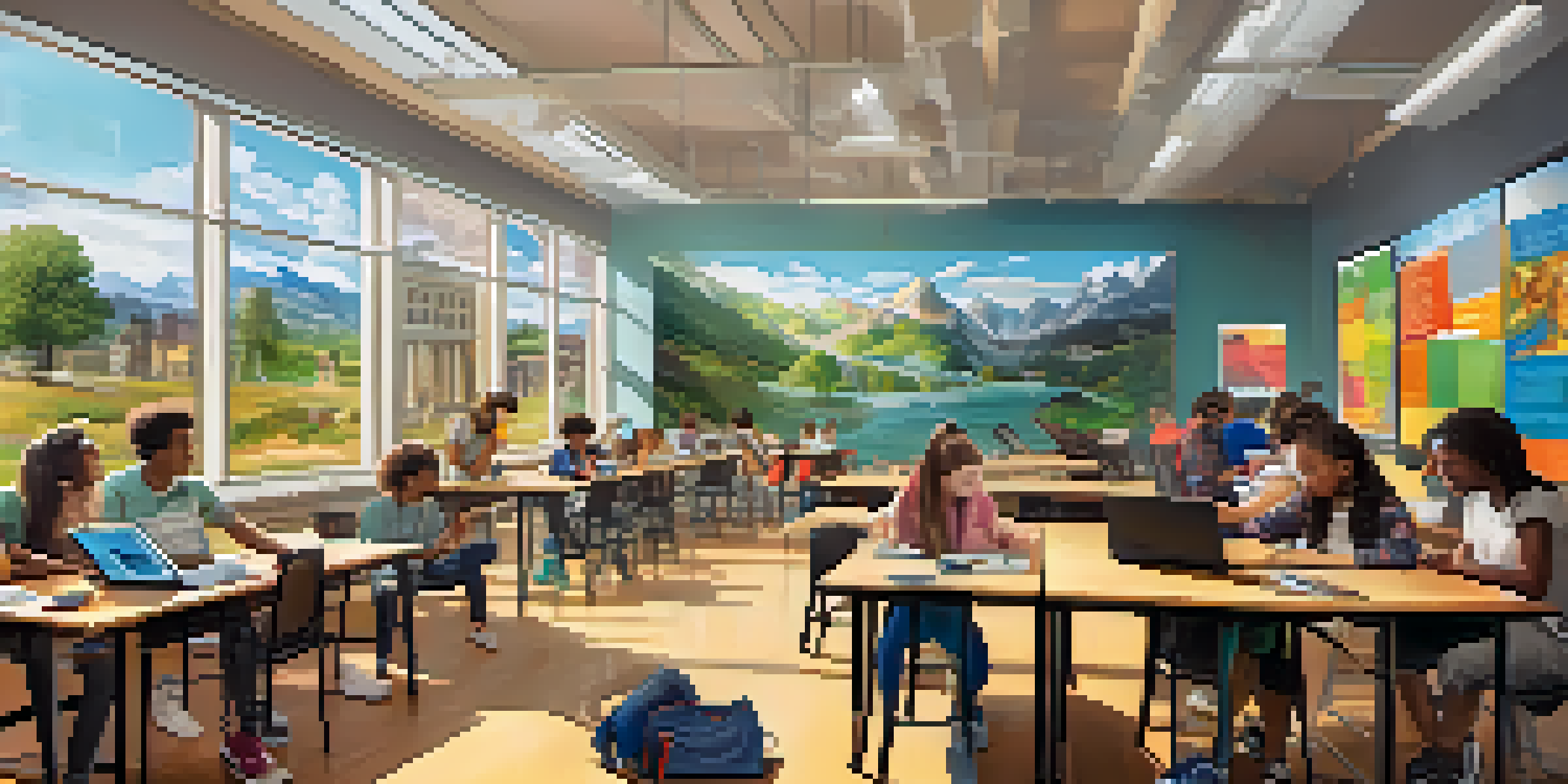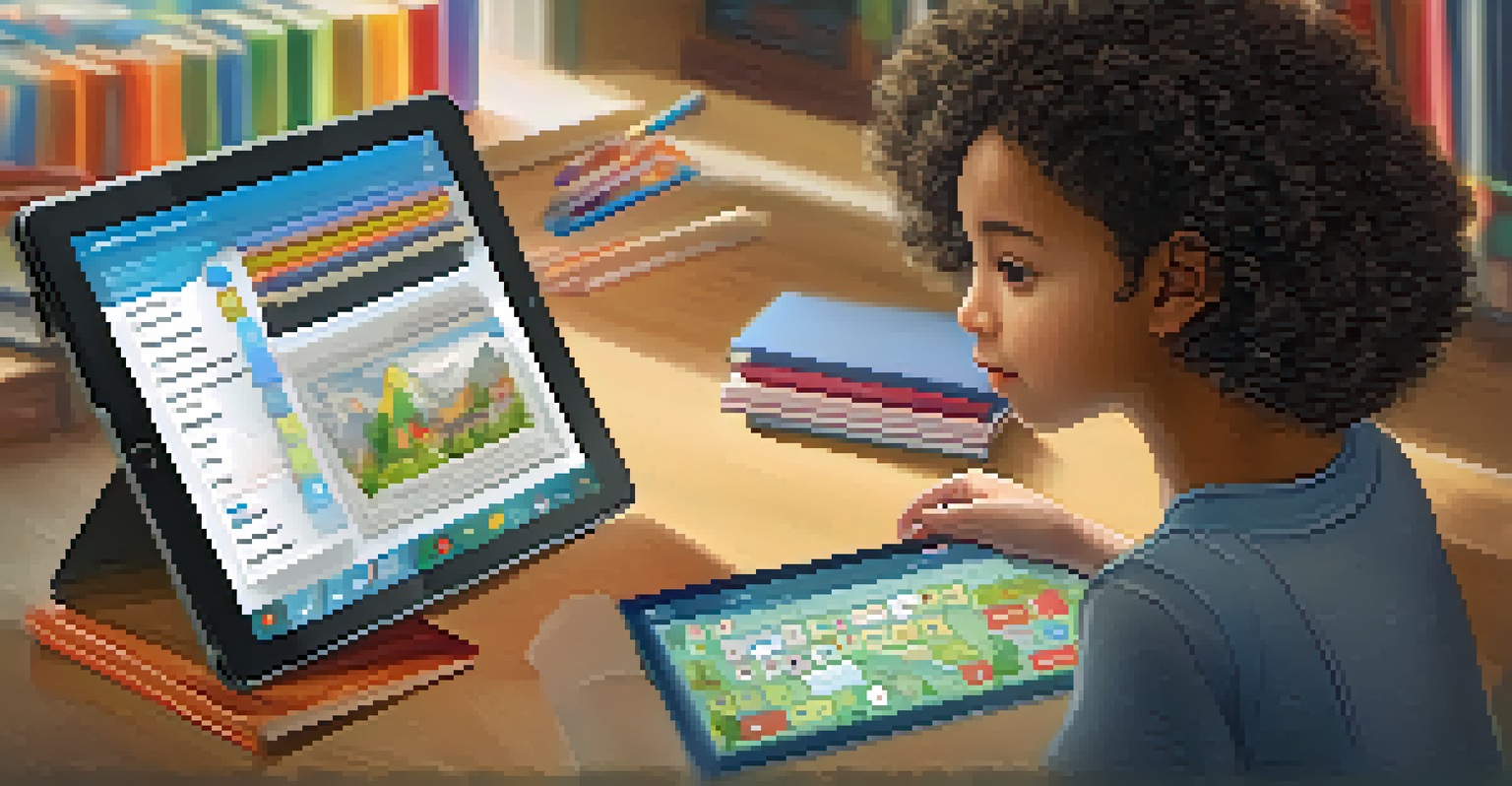Integrating Technology in Student-Centered Learning

Understanding Student-Centered Learning in the Digital Age
Student-centered learning is an educational approach that prioritizes the needs and interests of students. In this model, learners take an active role in their education, often working collaboratively and exploring subjects that intrigue them. As technology becomes more integrated into daily life, it’s essential to understand how it can enhance this learning style.
Education is not the filling of a pail, but the lighting of a fire.
In a digital landscape, student-centered learning shifts from traditional lectures to interactive experiences. For instance, using online discussion boards allows students to share ideas and engage with peers outside the classroom. This flexibility helps cater to various learning styles, making education more inclusive and personalized.
As we embrace technology, we must also consider how it impacts student autonomy. Tools like learning management systems (LMS) enable students to track their progress and take ownership of their learning journey. By aligning technology with student-centered practices, educators can create a more dynamic and responsive learning environment.
The Role of Technology in Facilitating Engagement
One of the primary benefits of integrating technology into student-centered learning is increased engagement. Interactive tools such as quizzes, polls, and gamified learning environments make lessons more appealing. When students can actively participate rather than passively listen, their interest and retention of information significantly improve.

Consider a classroom where students use virtual reality (VR) to explore historical sites. This immersive experience not only captures their attention but also deepens their understanding of the context and significance. By leveraging technology, educators can create engaging scenarios that bring lessons to life.
Engagement Through Technology
Integrating technology in education enhances student engagement by making learning interactive and appealing.
Furthermore, technology fosters collaboration among students. Platforms like Google Classroom allow them to work together on projects, enhancing their teamwork skills. This collaborative spirit is vital in preparing students for the modern workforce, where teamwork and communication are key.
Personalizing Learning Experiences with Technology
Personalization is a cornerstone of student-centered learning, and technology can greatly enhance this aspect. Adaptive learning software adjusts the difficulty of tasks based on individual student performance, ensuring that everyone is challenged appropriately. This tailored approach helps meet diverse needs within the classroom.
The great aim of education is not knowledge but action.
For example, platforms like Khan Academy offer personalized learning paths that allow students to progress at their own pace. This flexibility empowers learners, giving them control over their educational journey. When students can choose their learning pace and style, they are more likely to stay motivated and engaged.
Moreover, data analytics can provide valuable insights into student performance. Teachers can identify areas where students struggle and adjust their teaching strategies accordingly. This data-driven approach ensures that no student falls behind, promoting a more equitable learning environment.
Enhancing Communication Between Students and Educators
Effective communication is vital in student-centered learning, and technology plays a crucial role in this area. Tools like video conferencing and messaging apps facilitate real-time communication between students and educators, breaking down traditional barriers. This open line of communication fosters a supportive learning atmosphere.
Imagine a scenario where students can easily reach out to their teachers via a messaging platform to ask questions or seek clarification. This immediate access encourages students to engage more actively in their learning process, as they feel supported and valued. This kind of interaction can lead to improved academic outcomes.
Personalized Learning Experiences
Adaptive learning tools allow students to progress at their own pace, catering to diverse learning needs.
Additionally, technology can help provide feedback more efficiently. Digital platforms allow for quicker assessment and timely responses, enabling students to understand their strengths and areas for improvement. This constant feedback loop is essential for nurturing student growth and development.
Utilizing Multimedia to Support Diverse Learning Styles
Every student learns uniquely, and integrating multimedia into lessons can cater to various learning styles effectively. Resources such as videos, podcasts, and infographics can complement traditional teaching methods, making content more accessible. This variety helps engage visual, auditory, and kinesthetic learners alike.
For instance, a history lesson that incorporates videos and interactive timelines can captivate students who might struggle with text-heavy materials. This multimedia approach not only captures attention but also reinforces understanding by presenting information in diverse formats. It’s about meeting students where they are and helping them thrive.
Moreover, using multimedia can spark creativity and innovation. Students can create their own videos or podcasts to express their understanding of a topic, allowing them to take ownership of their learning. This creativity fosters a deeper connection to the material and encourages students to think critically.
Overcoming Challenges in Technology Integration
Despite the benefits, integrating technology in student-centered learning can present challenges. Issues such as lack of training, limited resources, and varying levels of student access to technology can hinder effective implementation. Educators must be prepared to navigate these obstacles to create meaningful learning experiences.
For example, teachers may need professional development to feel confident in using new technologies. Investing in training ensures that educators can fully leverage digital tools, ultimately benefiting students. By addressing these challenges head-on, schools can create a supportive environment for both teachers and learners.
Communication and Feedback
Technology facilitates effective communication between students and educators, leading to timely feedback and support.
Additionally, equity in access to technology is crucial. Schools should strive to provide resources and support to students who may lack access at home. By ensuring all students have the necessary tools, educators can create a truly inclusive learning environment that embraces the principles of student-centered learning.
Looking Ahead: The Future of Student-Centered Learning
As we look to the future, integrating technology into student-centered learning will only become more critical. With advancements in artificial intelligence, virtual reality, and interactive platforms, the possibilities for engaging students are endless. Education will continue to evolve, making learning more personalized and accessible than ever before.
Imagine a classroom where AI tailors lessons to individual student needs in real-time, creating a truly customized learning experience. This vision is not far off, as technology continues to innovate and reshape educational practices. Embracing these changes will empower students and educators alike.

Ultimately, the goal of integrating technology in student-centered learning is to foster a love for learning that lasts a lifetime. By creating engaging, personalized, and collaborative experiences, we can inspire the next generation of learners to thrive in an ever-changing world. The future of education is bright, and technology will play a pivotal role in shaping it.